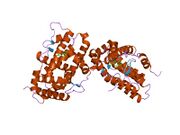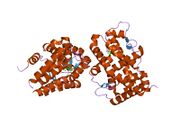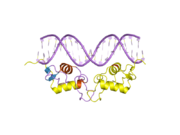Biology:Progesterone receptor
 Generic protein structure example |
The progesterone receptor (PR), also known as NR3C3 or nuclear receptor subfamily 3, group C, member 3, is a protein found inside cells. It is activated by the steroid hormone progesterone.
In humans, PR is encoded by a single PGR gene residing on chromosome 11q22,[1][2][3] it has two isoforms, PR-A and PR-B, that differ in their molecular weight.[4][5][6] The PR-B is the positive regulator of the effects of progesterone, while PR-A serve to antagonize the effects of PR-B.[7]
Mechanism
Progesterone is necessary to induce activation of the progesterone receptors. When no binding hormone is present the carboxyl terminal inhibits transcription. Binding to a hormone induces a structural change that removes the inhibitory action. Progesterone antagonists prevent the structural reconfiguration.
After progesterone binds to the receptor, restructuring with dimerization follows and the complex enters the nucleus and binds to DNA. There transcription takes place, resulting in formation of messenger RNA that is translated by ribosomes to produce specific proteins.
Structure
| Progesterone receptor, N-terminal | |||||||||
|---|---|---|---|---|---|---|---|---|---|
| Identifiers | |||||||||
| Symbol | Progest_rcpt_N | ||||||||
| Pfam | PF02161 | ||||||||
| InterPro | IPR000128 | ||||||||
| |||||||||
In common with other steroid receptors, the progesterone receptor has a N-terminal regulatory domain, a DNA binding domain, a hinge section, and a C-terminal ligand binding domain. A special transcription activation function (TAF), called TAF-3, is present in the progesterone receptor-B, in a B-upstream segment (BUS) at the amino acid terminal. This segment is not present in the receptor-A.
Isoforms
As demonstrated in progesterone receptor-deficient mice, the physiological effects of progesterone depend completely on the presence of the human progesterone receptor (hPR), a member of the steroid-receptor superfamily of nuclear receptors. The single-copy human (hPR) gene uses separate promoters and translational start sites to produce two isoforms, hPR-A and -B, which are identical except for an additional 165 amino acids present only in the N terminus of hPR-B.[8] Although hPR-B shares many important structural domains with hPR-A, they are in fact two functionally distinct transcription factors, mediating their own response genes and physiological effects with little overlap. Selective ablation of PR-A in a mouse model, resulting in exclusive production of PR-B, unexpectedly revealed that PR-B contributes to, rather than inhibits, epithelial cell proliferation both in response to estrogen alone and in the presence of progesterone and estrogen. These results suggest that in the uterus, the PR-A isoform is necessary to oppose estrogen-induced proliferation as well as PR-B-dependent proliferation.
Functional polymorphisms
Six variable sites, including four polymorphisms and five common haplotypes have been identified in the human PR gene .[9] One promoter region polymorphism, +331G/A, creates a unique transcription start site. Biochemical assays showed that the +331G/A polymorphism increases transcription of the PR gene, favoring production of hPR-B in an Ishikawa endometrial cancer cell line.[10]
Several studies have now shown no association between progesterone receptor gene +331G/A polymorphisms and breast or endometrial cancers.[11][12] However, these follow-up studies lacked the sample size and statistical power to make any definitive conclusions, due to the rarity of the +331A SNP. It is currently unknown which if any polymorphisms in this receptor are of significance to cancer. A study of 21 non-European populations identified two markers within the PROGINS haplotype of the PR gene as positively correlated with ovarian and breast cancer.[13]
Animal studies
Development
Knockout mice of the PR{{clarify|date=May 2023} severely impaired lobuloalveolar development of the mammary glands[14] as well as delayed but otherwise normal mammary ductal development at puberty.[15][16]
Behavior
During rodent perinatal life, progesterone receptor (PR) is known to be transiently expressed in both the ventral tegmental area (VTA) and the medial prefrontal cortex (mPFC) of the mesocortical dopaminergic pathway. PR activity during this time period impacts the development of dopaminergic innervation of the mPFC from the VTA. If PR activity is altered, a change in dopaminergic innervation of the mPFC is seen and tyrosine hydroxylase (TH), the rate-limiting enzyme for dopamine synthesis, in the VTA will also be impacted. TH expression in this area is an indicator of dopaminergic activity, which is believed to be involved in normal and critical development of complex cognitive behaviors that are mediated by the mesocortical dopaminergic pathway, such as working memory, attention, behavioral inhibition, and cognitive flexibility.[17]
Research has shown that when a PR antagonist, such as RU 486, is administered to rats during the neonatal period, decreased tyrosine hydroxylase immunoreactive (TH-ir) cells density, a strong co-expresser with PR-immunoreactivity (PR-ir), is seen in the mPFC of juvenile rodents. Later on, in adulthood, decreased levels of TH-ir in the VTA are also shown. This alteration in TH-ir fiber expression, an indicator of altered dopaminergic activity resulting from neonatal PR antagonist administration, has been shown to impair later performance on tasks that measure behavioral inhibition and impulsivity, as well as cognitive flexibility in adulthood. Similar cognitive flexibility impairments were also seen in PR knockout mice as a result of reduced dopaminergic activity in the VTA.[17]
Conversely, when a PR agonist, such as 17α-hydroxyprogesterone caproate, is administered to rodents during perinatal life, as the mesocortical dopaminergic pathway is developing, dopaminergic innervation of the mPFC increases. As a result, TH-ir fiber density also increases. Interestingly, this increase in TH-ir fibers and dopaminergic activity is also linked to impaired cognitive flexibility with increased perseveration later on in life.[18]
In combination, these findings suggest that PR expression during early development impact later cognitive functioning in rodents. Furthermore, it appears as though abnormal levels of PR activity during this critical period of mesocortical dopaminergic pathway development may have profound effects on specific behavioral neural circuits involved in the formation of later complex cognitive behavior.[17][18]
Ligands
Agonists
- Endogenous progestogens (e.g., progesterone)
- Synthetic progestogens (e.g., norethisterone, levonorgestrel, medroxyprogesterone acetate, megestrol acetate, dydrogesterone, drospirenone)
Mixed
- Selective progesterone receptor modulators (e.g., ulipristal acetate, telapristone acetate, vilaprisan, asoprisnil, asoprisnil ecamate)[19]
Antagonists
- Antiprogestogens (e.g., mifepristone, aglepristone, onapristone, lonaprisan, lilopristone, toripristone)[19]
Interactions
Progesterone receptor has been shown to interact with:
See also
- Membrane progesterone receptor
- Selective progesterone receptor modulator
- Phytoprogestogen
References
- ↑ "Complete amino acid sequence of the human progesterone receptor deduced from cloned cDNA". Biochemical and Biophysical Research Communications 143 (2): 740–8. March 1987. doi:10.1016/0006-291X(87)91416-1. PMID 3551956.
- ↑ "The progesterone receptor gene maps to human chromosome band 11q13, the site of the mammary oncogene int-2". Proceedings of the National Academy of Sciences of the United States of America 84 (9): 2877–81. May 1987. doi:10.1073/pnas.84.9.2877. PMID 3472240. Bibcode: 1987PNAS...84.2877L.
- ↑ ensembl.org, Gene: ESR1 (ENSG00000091831)
- ↑ "Progesterone receptors: various forms and functions in reproductive tissues". Frontiers in Bioscience 10 (1–3): 2118–30. 2005. doi:10.2741/1685. PMID 15970482.
- ↑ Kase, Nathan G.; Speroff, Leon; Glass, Robert L. (1999). Clinical gynecologic endocrinology and infertility. Hagerstown, MD: Lippincott Williams & Wilkins. ISBN 978-0-683-30379-7.
- ↑ Fritz, Marc A.; Speroff, Leon (2005). Clinical gynecologic endocrinology and infertility. Hagerstown, MD: Lippincott Williams & Wilkins. ISBN 978-0-7817-4795-0.
- ↑ Falcone, Tommaso; Hurd, William W. (22 May 2013). Clinical Reproductive Medicine and Surgery: A Practical Guide. Springer Science & Business Media. pp. 39–. ISBN 978-1-4614-6837-0. https://books.google.com/books?id=TAYnR1b8jRkC&pg=PA39.
- ↑ "Two distinct estrogen-regulated promoters generate transcripts encoding the two functionally different human progesterone receptor forms A and B". The EMBO Journal 9 (5): 1603–14. May 1990. doi:10.1002/j.1460-2075.1990.tb08280.x. PMID 2328727.
- ↑ "Genetic variation in the progesterone receptor gene and ovarian cancer risk". American Journal of Epidemiology 161 (5): 442–51. March 2005. doi:10.1093/aje/kwi064. PMID 15718480.
- ↑ "A functional polymorphism in the promoter of the progesterone receptor gene associated with endometrial cancer risk". Proceedings of the National Academy of Sciences of the United States of America 99 (19): 12263–8. September 2002. doi:10.1073/pnas.192172299. PMID 12218173. Bibcode: 2002PNAS...9912263D.
- ↑ "No association between the progesterone receptor gene +331G/A polymorphism and breast cancer". Cancer Epidemiology, Biomarkers & Prevention 13 (6): 1084–5. June 2004. doi:10.1158/1055-9965.1084.13.6. PMID 15184270.
- ↑ "No association between progesterone receptor gene +331G/A polymorphism and endometrial cancer". Cancer Epidemiology, Biomarkers & Prevention 15 (7): 1415–6. July 2006. doi:10.1158/1055-9965.EPI-06-0215. PMID 16835347.
- ↑ Rockwell, L. C.; Rowe, E. J.; Arnson, K.; Jackson, F.; Froment, A.; Ndumbe, P.; Seck, B.; Jackson, R. et al. (2012). "Worldwide distribution of allelic variation at the progesterone receptor locus and the incidence of female reproductive cancers". American Journal of Human Biology 24 (1): 42–51. doi:10.1002/ajhb.21233. PMID 22121098.
- ↑ "Mammary gland development". Wiley Interdisciplinary Reviews. Developmental Biology 1 (4): 533–57. 2012. doi:10.1002/wdev.35. PMID 22844349.
- ↑ "Minireview: Progesterone Regulation of Proliferation in the Normal Human Breast and in Breast Cancer: A Tale of Two Scenarios?". Molecular Endocrinology 29 (9): 1230–42. September 2015. doi:10.1210/me.2015-1152. PMID 26266959.
- ↑ "Amphiregulin mediates progesterone-induced mammary ductal development during puberty". Breast Cancer Research 15 (3): R44. May 2013. doi:10.1186/bcr3431. PMID 23705924.
- ↑ 17.0 17.1 17.2 "Progesterone Receptor Expression in the Developing Mesocortical Dopamine Pathway: Importance for Complex Cognitive Behavior in Adulthood". Neuroendocrinology 103 (3–4): 207–22. 2016. doi:10.1159/000434725. PMID 26065828.
- ↑ 18.0 18.1 "Exposure to the Synthetic Progestin, 17α-Hydroxyprogesterone Caproate During Development Impairs Cognitive Flexibility in Adulthood". Endocrinology 157 (1): 77–82. January 2016. doi:10.1210/en.2015-1775. PMID 26556535.
- ↑ 19.0 19.1 "Tracking progesterone receptor-mediated actions in breast cancer". Pharmacology & Therapeutics 142 (1): 114–25. April 2014. doi:10.1016/j.pharmthera.2013.11.010. PMID 24291072.
- ↑ "Selective interactions of Kruppel-like factor 9/basic transcription element-binding protein with progesterone receptor isoforms A and B determine transcriptional activity of progesterone-responsive genes in endometrial epithelial cells". The Journal of Biological Chemistry 278 (24): 21474–82. June 2003. doi:10.1074/jbc.M212098200. PMID 12672823.
- ↑ "The opposing transcriptional activities of the two isoforms of the human progesterone receptor are due to differential cofactor binding". Molecular and Cellular Biology 20 (9): 3102–15. May 2000. doi:10.1128/MCB.20.9.3102-3115.2000. PMID 10757795.
- ↑ "The Angelman syndrome-associated protein, E6-AP, is a coactivator for the nuclear hormone receptor superfamily". Molecular and Cellular Biology 19 (2): 1182–9. February 1999. doi:10.1128/mcb.19.2.1182. PMID 9891052.
Further reading
- "Progesterone receptor activity in leiomyomatosis peritonealis disseminata". International Journal of Gynecological Pathology 18 (3): 259–64. July 1999. doi:10.1097/00004347-199907000-00012. PMID 12090595.
- "Progesterone receptor transcription and non-transcription signaling mechanisms". Steroids 68 (10–13): 761–70. November 2003. doi:10.1016/S0039-128X(03)00129-6. PMID 14667966.
- "Progesterone-dependent regulation of female reproductive activity by two distinct progesterone receptor isoforms". Steroids 68 (10–13): 771–8. November 2003. doi:10.1016/S0039-128X(03)00126-0. PMID 14667967.
- "Ligand and DNA-dependent phosphorylation of human progesterone receptor in vitro". Proceedings of the National Academy of Sciences of the United States of America 89 (7): 2664–8. April 1992. doi:10.1073/pnas.89.7.2664. PMID 1557371. Bibcode: 1992PNAS...89.2664B.
- "Two distinct estrogen-regulated promoters generate transcripts encoding the two functionally different human progesterone receptor forms A and B". The EMBO Journal 9 (5): 1603–14. May 1990. doi:10.1002/j.1460-2075.1990.tb08280.x. PMID 2328727.
- "Mechanisms of nuclear localization of the progesterone receptor: evidence for interaction between monomers". Cell 57 (7): 1147–54. June 1989. doi:10.1016/0092-8674(89)90052-4. PMID 2736623.
- "The interaction of canrenone with oestrogen and progesterone receptors in human uterine cytosol". British Journal of Clinical Pharmacology 15 (1): 95–101. January 1983. doi:10.1111/j.1365-2125.1983.tb01470.x. PMID 6849751.
- "Sequence and characterization of a coactivator for the steroid hormone receptor superfamily". Science 270 (5240): 1354–7. November 1995. doi:10.1126/science.270.5240.1354. PMID 7481822. Bibcode: 1995Sci...270.1354O.
- "Identification of phosphorylation sites unique to the B form of human progesterone receptor. In vitro phosphorylation by casein kinase II". The Journal of Biological Chemistry 269 (49): 31034–40. December 1994. doi:10.1016/S0021-9258(18)47386-3. PMID 7983041.
- "No evidence for the expression of the progesterone receptor on peripheral blood lymphocytes during pregnancy". Human Reproduction 9 (8): 1546–9. August 1994. doi:10.1093/oxfordjournals.humrep.a138746. PMID 7989520.
- "Negative interaction between the RelA(p65) subunit of NF-kappaB and the progesterone receptor". The Journal of Biological Chemistry 271 (11): 6217–24. March 1996. doi:10.1074/jbc.271.11.6217. PMID 8626413.
- "Progesterone receptor immunoreactivity at the maternofetal interface of first trimester pregnancy: a study of the trophoblast population". Human Reproduction 11 (2): 413–9. February 1996. doi:10.1093/humrep/11.2.413. PMID 8671234.
- "Differential interaction of nuclear receptors with the putative human transcriptional coactivator hTIF1". The Journal of Biological Chemistry 272 (18): 12062–8. May 1997. doi:10.1074/jbc.272.18.12062. PMID 9115274.
- "Steroid receptor induction of gene transcription: a two-step model". Proceedings of the National Academy of Sciences of the United States of America 94 (15): 7879–84. July 1997. doi:10.1073/pnas.94.15.7879. PMID 9223281. Bibcode: 1997PNAS...94.7879J.
- "Expression of progesterone receptor mRNA in the first trimester human placenta". Biochemistry and Molecular Biology International 42 (6): 1235–40. September 1997. doi:10.1080/15216549700203701. PMID 9305541.
- "Progesterone receptor variants found in breast cells repress transcription by wild-type receptors". Breast Cancer Research and Treatment 48 (3): 231–41. April 1998. doi:10.1023/A:1005941117247. PMID 9598870.
- "Atomic structure of progesterone complexed with its receptor". Nature 393 (6683): 392–6. May 1998. doi:10.1038/30775. PMID 9620806. Bibcode: 1998Natur.393..392W.
- "High-mobility group chromatin proteins 1 and 2 functionally interact with steroid hormone receptors to enhance their DNA binding in vitro and transcriptional activity in mammalian cells". Molecular and Cellular Biology 18 (8): 4471–87. August 1998. doi:10.1128/mcb.18.8.4471. PMID 9671457.
- "The Angelman syndrome-associated protein, E6-AP, is a coactivator for the nuclear hormone receptor superfamily". Molecular and Cellular Biology 19 (2): 1182–9. February 1999. doi:10.1128/mcb.19.2.1182. PMID 9891052.
External links
- Progesterone+Receptors at the US National Library of Medicine Medical Subject Headings (MeSH)
 |









